
Towhees, Sparrows, Grosbeaks and Buntings
Oregon has 27 species of towhees, sparrows, grosbeaks and buntings.

Types of Towhees, Sparrows, Grosbeaks and Buntings

The Chipping sparrow is a small and slender sparrow that has a distinctive sharp chip note and simple, trilling song. Breeding adults display a chestnut crown, a black eye-stripe, and crisp white eyebrow. After nesting season, both male and female lose their distinctive bright cap for a streaky dull brown head pattern that is similar to other winter sparrows.
It is a common summer resident in open forests and drier woodland edges throughout Oregon and is especially abundant in the Blue Mountains. The Chipping sparrow is an Oregon Conservation Strategy Species in the Willamette Valley ecoregion.
Hear the song of the Chipping sparrow
Photo by ©Keith Kohl, ODFW

Flocks of these big, brown, plain sparrows are a common sight in winter in western Oregon. By early spring their faded head markings become a beautiful gold, black and white, and their plaintive descending songs become frequently heard from almost any large brush pile.
They are an abundant migrant in western Oregon, less common farther east, and abundant in winter throughout the Willamette Valley.
Hear the song of the Golden-crowned sparrow
Photo by Dave Budeau, ODFW

This is a sparrow of the dry brushlands. The Clay-colored sparrow breeds chiefly across the northern prairies from northeast British Columbia east to Michigan and south into Colorado. It winters in the southern United States and Mexico.
It has expanded its range westward and northward in recent years and is now nesting in small numbers in eastern Washington. It was seldom reported west of the Rocky Mountains prior to 1960. Since that time, it has become a regular migrant and wintering bird along the west coast.
Hear the song of the Clay-colored sparrow
Clay-colored sparrow. Photo by "Always a birder", Flickr

This small, dark-headed sparrow flashing white outer tail feathers is one of the state's most abundant species and one of the easiest to identify.
When not nesting, the Dark-eyed junco might be seen nearly anywhere in the state. It is a regular visitor to city parks and neighborhood bird feeders.
Most juncos occurring in Oregon show dark hoods, dull rusty-brown backs, and pinkish brown below the wings. Some are grayish, lacking much of the brown tones.
They are most often observed in single-species flocks but individuals and small groups often join mixed wintering sparrow flocks. It is resident from the Columbia River south to Douglas County and from the Cascades to the coast. There is some southward movement in winter.
Hear the song of the Dark-eyed junco
Photo by Bob Swingle, ODFW
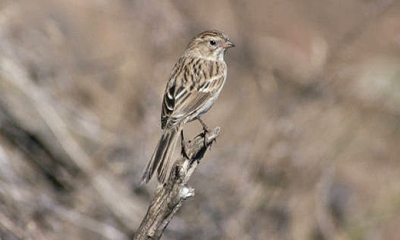
One of the most nondescript birds found in Oregon, this sparrow makes up for its drab appearance by its extraordinary song. It is by far the most abundant bird breeding in the vast sagebrush expanses of the Intermountain West.
The Brewer's sparrow is an abundant migrant and summer resident east of the Cascades summit, particularly in the southeast quarter of the state among the vast sagebrush communities of the Great Basin Shrub-steppe. In the Columbia Plateau ecoregion, it is an Oregon Conservation Strategy Species.
Hear the song of the Brewer's sparrow
Photo by Dave Menke, USFWS
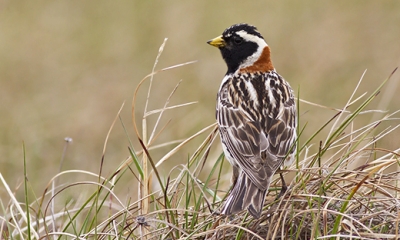
Within wintering flocks of Horned Larks in the valleys of eastern Oregon, and along flats bordering coastal estuaries in the fall, it is sometimes possible to find flocks of this large arctic-breeding sparrow.
Their habit of running along the ground in a crouch rather than flying makes them a challenge to observe, but in flight their characteristic rattling call is unmistakable. Otherwise, in fall and winter plumage, they appear as brownish streaked sparrows. In flight their dark tail with white sides is conspicuous.
Along the outer Oregon coast, the Lapland longspur is an uncommon but regular fall migrant, especially at the south jetty of the Columbia River. They are irregular on the coast in winter and spring. The longspur is regularly reported in eastern Oregon, but numbers vary from year to year.
Hear the song of the Lapland longspur
Photo by Zac Pohlen, Flickr

The song of this bird is one of the characteristic sounds of spring evenings in much of the high desert country of eastern Oregon.
This temperate migrant is a ground-nesting, ground-foraging bird of most of the grassland, agricultural land, and shrubs steppe habitats of Oregon.
The streaked brownish plumage of the Vesper sparrow is similar to that of several small to medium-sized sparrows, except for white outer tail feathers, shown most conspicuously in flight.
The Oregon vesper sparrow is an Oregon Conservation Strategy Species in the Klamath Mountains and Willamette Valley ecoregions.
Hear the song of the Vesper sparrow
Photo by Simon Wray, ODFW
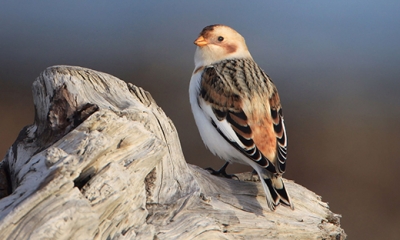
The Snow bunting is a large finch that breeds throughout the high arctic tundra. In winter, many move south, sometimes forming large flocks in open grasslands, steppes, and dunes.
When feeding in agricultural fields, these flocks may be hidden among the stubble, but when alarmed they often arise as a group and whirl about in a white cloud before returning to their spot or a nearby one.
Oregon is at the southern edge of their winter range, and their wanderings about the state are erratic. In basic plumage, they are buffy and cream-colored with black and white wings.
Hear the song of the Snow bunting
Photo by Nigel, Flickr

The adult Lark sparrow is one of the most easily recognized passerines. The head pattern is sharp and crisp, with a chestnut crown and cheek patch surrounded by alternating white and black stripes. White underparts with a a small black central spot and a long, blackish tail with conspicuous white wing corners further aid identification.
Courtship behaviors, including turkey-like strutting by males, differ markedly from that of other passerines.
In Oregon, the Lark sparrow is a locally common summer resident and migrant east of the Cascades.
Hear the song of the Lark sparrow
Photo by Beken Bulgic Schneider, Flickr

This species breeds from northeast British Columbia to Nova Scotia and south to north Georgia. It winters in Middle and South America. Small numbers regularly occur along the west coast, especially in spring.
The majority of Oregon records have occurred from early March through July, mostly from mid-May to mid-June. Individuals are occasionally found from mid-September to mid-January, mostly birds that remained less than five days.
Here the song of the Rose-breasted grosbeak
Photo by Anna Hesser, Flickr

This uncommon inhabitant of Oregon's high desert can be a challenge to find unless the observer becomes familiar with its territorial song and preferred habitat. Habitat requirements are specialized and population distribution and densities are highly variable from year to year in Oregon.
The Black-throated sparrow occurs along boulder-strewn, sparsely vegetated slopes of arid deserts. They prefer warm dry sunny slopes of desert basins.
Hear the song of the Black-throated sparrow
Photo by Ashley Tubbs, Flickr
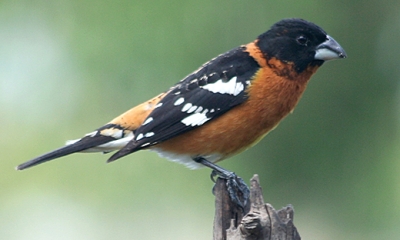
For many, the rich, melodious song of the Black-headed grosbeak is the music of springtime in Oregon. The handsome males, with their bold pattern of cinnamon, black, and white, are among our most striking songbirds, and area familiar site in parks and gardens as well as in almost every forest type in the state. The buffy, streaked females are less conspicuous, but are also accomplished singers.
The Black-headed grosbeak is a common to fairly common breeder and common migrant in forested regions throughout the state.
Hear the song of the Black-headed grosbeak
Photo by David Bronson

Although common within its range, this handsome sparrow can easily be overlooked. The gray head, black malar stripe, white eyebrow, and prominent black spot set in the middle of a white breast identify the bird. It is widespread throughout the extensive shrub-steppe of central and eastern Oregon.
The principal breeding range of Sagebursh sparrow is southeast and central Oregon. It is found throughout the arid expanses of the Great Basin and usually associated with big sage.
Although considered by some authors to be a sagebrush obligate, Sagebrush sparrows have been found in other plant communities exclusive of sagebrush.
Hear the song of the Sagebrush sparrow
Photo by Mick Thompson, Flickr

All of Oregon's blue-colored birds are appreciated for their dazzling appearance, but the striking plumage of this summer visitor is accompanied by a song described as vivacious, varied, well-articulated and sweet.
Males are unmistakable when singing from a prominent perch, flashing deep azure upper parts with rich orange-brown breast and flanks, a white belly, and white wing bars. Females are warm brown and relatively plain, though they share with males the habit of twitching the tail to one side when excited.
The Lazuli bunting is fairly common in low-elevation dry valleys in Curry County but are becoming uncommon north through the Coquille River Valley. They are rare along the immediate coast from north Coos County north to Cascade Head, Lincoln City. They are a common breeder in the Rogue and Umpqua River valleys and fairly common in the south Willamette Valley, becoming less common north to the Columbia River.
Hear the song of the Lazuli bunting
Photo by Charlotte Ganskopp

The buzzy, insect-like song of the Savannah sparrow is a characteristic sound of open landscapes dominated by grasslands throughout Oregon.
Savannah sparrows are usually heard or seen when perched atop a fence post, small shrub, or tall weed, or running on the ground between openings in vegetation until the bird abruptly drops down into cover.
The Savannah sparrow nests on the ground, often in a slight depression and well concealed by a canopy of dead vegetation or partially tucked under a clump of vegetation.
Hear the song of the Savannah sparrow
Photo by Dave Budeau, ODFW
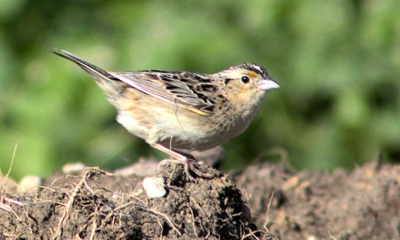
The Grasshopper sparrow is one of the more enigmatic and erratic birds in Oregon. A small population may appear in an area, persist for a few years, and then disappear, only to return at some later time.
It is difficult to detect, because of both its quiet, insect-like song and its reclusive habits. Males sing from elevated perches, such as flower stalks or fence posts before diving back among the grasses. It occurs in scattered "colonies" along the unforested northern slopes of the Blue Mountains.
The Grasshopper sparrow is an Oregon Conservation Strategy Species in the Columbia Plateau, Klamath Mountains, and Willamette Valley ecoregions.
Hear the song of the Grasshopper sparrow
Photo by Kenneth Cole Schneider, Flickr
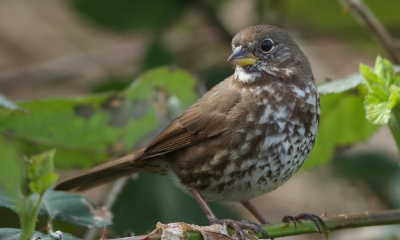
These big, medium-brown sparrows with variable grayish faces and heavily streaked or blotch undersides can be found in summer at higher elevations across much of the state except the Coast Range.
Darker brown birds from more northerly breeding populations are common in western Oregon in winter, often coming to feeders, where they scratch like towhees for seed on the ground.
Hear the song of the Fox sparrow
Photo by Robin Horn, Flickr
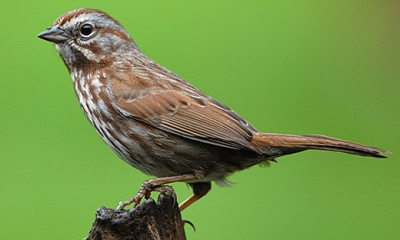
Although not brilliantly plumaged, the conspicuous Song Sparrow is one of the more regularly seen birds in Oregon.
Defensive and curious, when approached it readily announces its presence with loud chips and often excitedly rises to a conspicuous perch to confront the interloper.
The Song sparrow is well named as both male and female have a variety of songs that may be heard at any time of year, and juvenile birds begin to sing full songs within two months of hatching.
The Song sparrow is a common and widespread resident of western Oregon.
Hear the song of the Song sparrow
Photo by Dave Budeau, ODFW
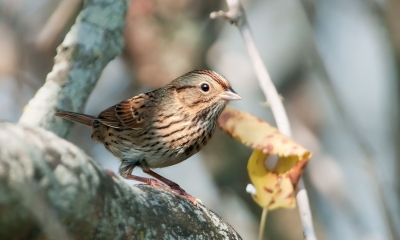
This small tan-and-gray sparrow with a delicately streaked upper breast is found in summer in wet mountain meadows where its bubbly song can be heard from low shrubs.
It winters in brushy lowland areas where it skulks in tall grass and weeds and is usually seen for only a moment. It breeds locally above 3,000 feet in the west Cascades and winters in the valleys west of the cascades.
Hear the song of the Lincoln's sparrow
Photo by Kelly Colgan-Azar, Flickr

A large and colorful member of the sparrow family, the Green-tailed towhee is perhaps more recognizable by its eye-catching chestnut crown than by its less intense green-gray back and olive tail.
As a ground forager, it spends most of its time on the ground or in thick cover, scratching about industriously in the leaf litter, and it may go unnoticed. But its catlike mewing call, which it often gives from a brushy perch, is one of the quintessential sounds of the shrublands of the east slope of the Cascades and the Great Basin.
It is locally fairly common east of the Cascades in summer and the most common in the north Great Basin, where it is found in nearly all mountain ranges.
Photo by Simon Wray, ODFW

The Swamp sparrow uses wet areas that have thick vegetation for cover. Several glimpses of this reclusive bird may be required before it can safely be separated from Lincoln's sparrow or the more common Song sparrow, though its distinctive call will give it away to observers familiar with it. Chestnut coloration on the wing coverts helps separate this species from other wintering sparrows.
The Swamp swallow is a rare to uncommon spring and fall transient and winter visitant in western Oregon, especially along the coast.
Hear the song of the Swamp sparrow
Photo from USFWS

This well-known ground-dwelling bird is black above on the male and brown on the female, including the entire head and upper breast. On both sexes the upperparts are spotted with white on the wings and the long tail. It has rufous sides and a white belly.
It frequents brushy areas and is common at bird feeders wherever seed is scattered on the ground, but does not feed far from cover. The varied song usually has one to three parts.
The Spotted towhee breeds statewide and winters primarily west of the Cascades and in small numbers in lowland areas east of the Cascades.
Hear the song of the Spotted towhee
Photo by Charlotte Ganskopp

Familiar to anyone from the eastern United States and Canada, this sparrow is much less common in Oregon.
Adults show both a white-striped and tan-striped morph, while first year birds resemble tan-striped adults but are typically more heavily streaked underneath. Even the dullest first-year birds have a distinct rectangular white throat patch, often set off with a partial black border.
The White-throated sparrow is an uncommon migrant and winter visitor, mainly in western Oregon.
Hear the call of the White-throated sparrow
Photo by ©Keith Kohl, ODFW

The California towhee can be found in chaparral habitats of southern Oregon, quietly flitting in and out of the brush in search of seeds. It is a plain brown bird with a rusty throat patch and undertail coverts. It is noticeably larger than the Spotted towhee. Its long slender tail is also a useful identifying feature. Sexes cannot be told apart in the field, but juveniles can be distinguished by the extensive streaking and spotting of the underparts.
The California towhee is a fairly common permanent resident throughout the Rogue, Applegate, and Illinois Valleys.
Hear the song of the California towhee
Photo by David Barton, Flickr
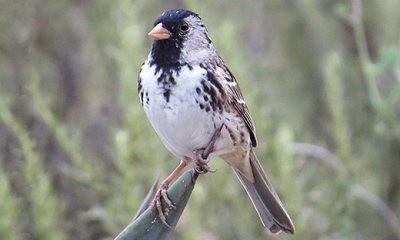
This large sparrow is white below and in most plumages has at least some black around the face or throat, more in adults than younger birds. Cheeks are golden-tan in fall and winter and grayish in spring. It is streaked above. It is a winter visitor usually found with other sparrows.
A very rare migrant and rare but regular visitor, you can find the Harris's sparrow statewide. Numbers vary considerably from year to year, but a few birds are typically found in the state every year. They are most regular in the Columbia Basin and in valleys within the Blue Mountains.
Photo by Brittany O'Connor, Flickr

This winter visitor is a study in gray and tan, with a small dark spot on an otherwise gray breast, dull rufous stripes on the side of the head and crown, and brown wings with distinct white stripes.
Tree sparrows visit Oregon only in winter, mainly in lowlands within the Blue Mountains and Owyhee upland regions with a few farther west in some years. They frequent willow clumps in grassy areas and occur occasionally at feeders.
Hear the song of the American tree sparrow
Photo by Eric Began, Flickr
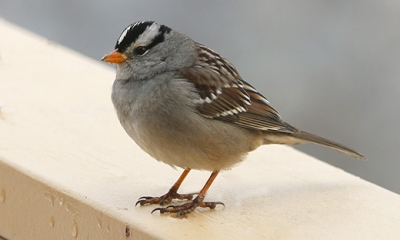
This large brown sparrow with its handsome black-and-white head pattern is a common breeder in brushy semi-open country throughout much of the state. In winter, it is frequently found in large flocks, often in the company of Golden-crowned sparrows and other seed eaters.
White-crowns are easily seen as they feed on the ground, repeatedly dashing back into the cover of dense shrubs before emerging for another foraging bout.
Hear the song of the White-crowned sparrow
Photo by Kathy Munsel, ODFW

